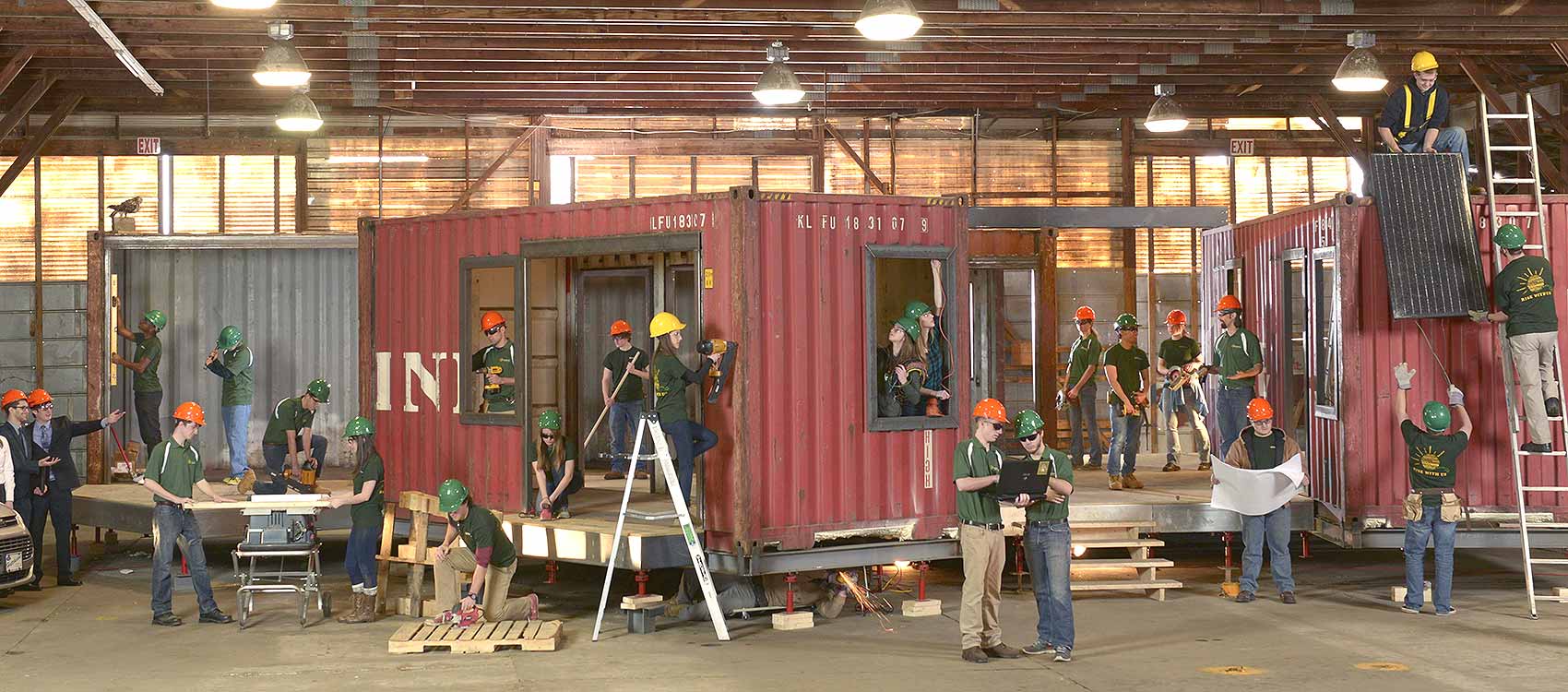
Missouri S&T: Missouri University of Science and Technology
Team website: The Nest Home
Just as birds use materials from their environment to build a nest, Missouri University of Science and Technology reused common materials to build its U.S. Department of Energy Solar Decathlon 2015 entry. Three refurbished shipping containers form the structure of the house. Innovative technologies such as greywater reclamation and a home automation system pair with passive design techniques to reduce overall energy consumption and improve efficiency. Collectively, these elements form a balanced blend of modern design, comfort, and sustainability.
The Missouri University of Science and Technology previously competed in Solar Decathlon 2002, Solar Decathlon 2005, Solar Decathlon 2007, Solar Decathlon 2009, and Solar Decathlon 2013.
Design Philosophy
The Nest Home is designed to prove that a net-zero home can comfortably and reliably meet the needs of a small family. Repurposed materials are used throughout for affordability and to extend their lifecycle. Three decommissioned shipping containers are set around a central gathering space to create a deconstructed triangle inspired by the shape of a bird's nest. The floor plan promotes togetherness while providing room for privacy. Wood siding reclaimed from shipping pallets shields the exterior, while carpeting made of reprocessed fishing nets covers the floor. Recycled denim batting in the interior walls provides insulation.
The Nest Home demonstrates the affordability of sustainable design and smart living through integrated systems. A greywater system gathers water from showers to reduce water consumption by up to 25%. A home automation system monitors interior and exterior conditions to make appropriate, and even predictive, adjustments to the HVAC system, interior lighting, and windows. Finally, hydroponic gardens provide residents with fresh produce year-round.
Photos
Features
- A greywater reclamation system treats water from the bathroom sink, shower, and laundry for reuse throughout the house and as source water in a garden or hydroponic system.
- Three hydroponic gardens provide controlled environments to produce fresh vegetables and herbs.
- DIY projects—including planter boxes made from shipping pallets, bathroom tile trim made from reclaimed ceramic fragments, and a concrete countertop inlaid with recycled glass—give new life to materials.
Technologies
- An array of 24 PV panels powers the house and an electric vehicle. Each panel contains a micro-inverter to eliminate the need for a centralized inverter and transform direct current to alternating current at the source.
- Automated windows can be programmed to respond to changing conditions and support the HVAC system.
- A home automation system automatically turns lights off when the home is empty and uses light harvesting technology to dim or brighten lights in real time as needed.
Videos
Market Strategy
The Nest Home is built for the needs of a growing family. The intimate floorplan is conducive to family-friendly activities, while the deconstructed geometry of the living space allows occupants to enjoy privacy when they wish. The main structure can be expanded by adding more containers to provide more space as the family grows. Comfort and convenience is assured for all stages of family life—from a full nest to an empty nest.
What's Next
After Solar Decathlon 2015, the Nest Home will return to Rolla, Missouri, where it will be placed on a permanent foundation as part of the Solar Suburb on the Missouri S&T campus. It will serve as student housing in which tenants participate in the university's ongoing smart-living research and development program and provide free tours to anyone interested in learning about sustainable living.
Contact
Mary Puleo
314-853-9971
Neither the United States, nor the Department of Energy, nor the Alliance for Sustainable Energy LLC, nor any of their contractors, subcontractors, or their employees make any warranty, express or implied, or assume any legal liability or responsibility for the accuracy, completeness, or usefulness for any purpose of any technical resources or data attached or otherwise presented here as reference material.
